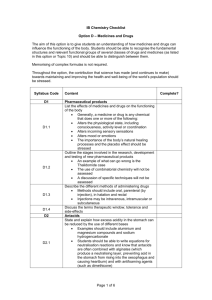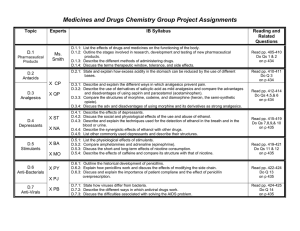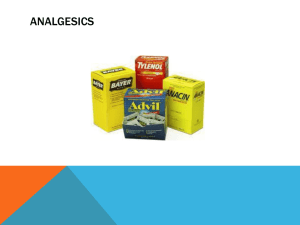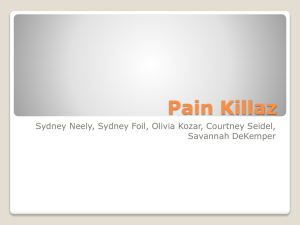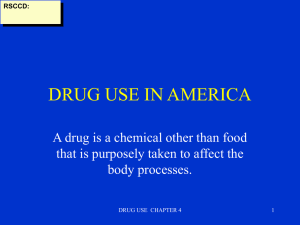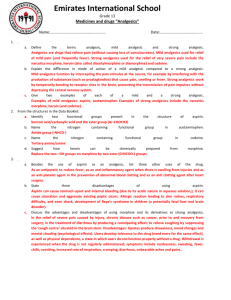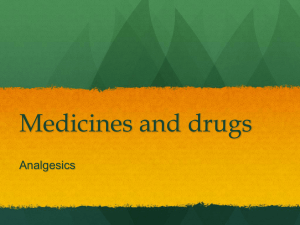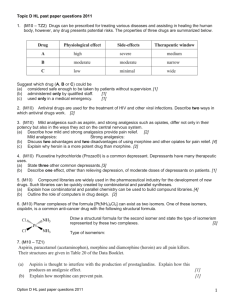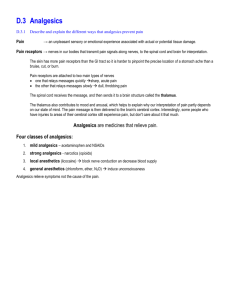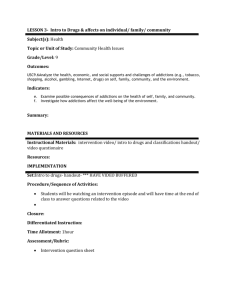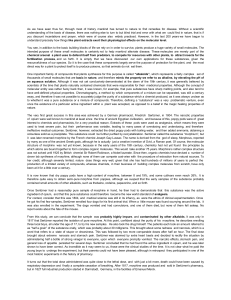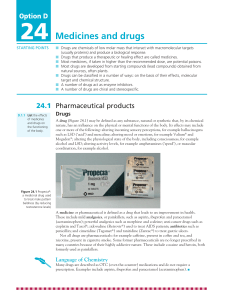IB Chemistry II Option D Study Guide
advertisement
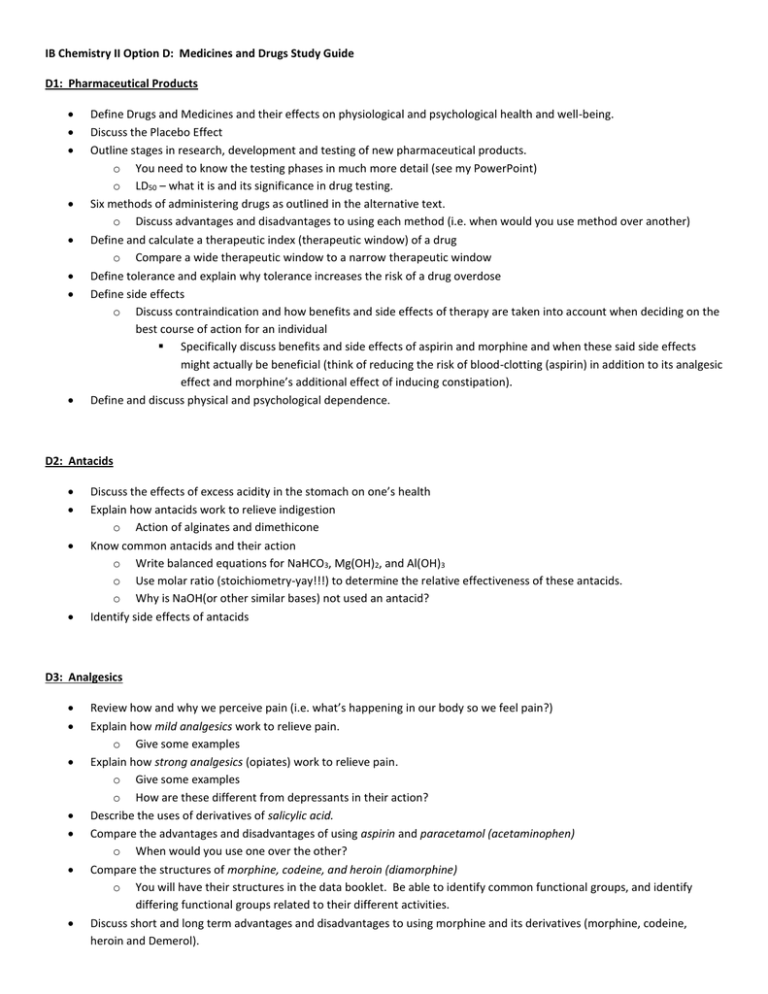
IB Chemistry II Option D: Medicines and Drugs Study Guide D1: Pharmaceutical Products Define Drugs and Medicines and their effects on physiological and psychological health and well-being. Discuss the Placebo Effect Outline stages in research, development and testing of new pharmaceutical products. o You need to know the testing phases in much more detail (see my PowerPoint) o LD50 – what it is and its significance in drug testing. Six methods of administering drugs as outlined in the alternative text. o Discuss advantages and disadvantages to using each method (i.e. when would you use method over another) Define and calculate a therapeutic index (therapeutic window) of a drug o Compare a wide therapeutic window to a narrow therapeutic window Define tolerance and explain why tolerance increases the risk of a drug overdose Define side effects o Discuss contraindication and how benefits and side effects of therapy are taken into account when deciding on the best course of action for an individual Specifically discuss benefits and side effects of aspirin and morphine and when these said side effects might actually be beneficial (think of reducing the risk of blood-clotting (aspirin) in addition to its analgesic effect and morphine’s additional effect of inducing constipation). Define and discuss physical and psychological dependence. D2: Antacids Discuss the effects of excess acidity in the stomach on one’s health Explain how antacids work to relieve indigestion o Action of alginates and dimethicone Know common antacids and their action o Write balanced equations for NaHCO3, Mg(OH)2, and Al(OH)3 o Use molar ratio (stoichiometry-yay!!!) to determine the relative effectiveness of these antacids. o Why is NaOH(or other similar bases) not used an antacid? Identify side effects of antacids D3: Analgesics Review how and why we perceive pain (i.e. what’s happening in our body so we feel pain?) Explain how mild analgesics work to relieve pain. o Give some examples Explain how strong analgesics (opiates) work to relieve pain. o Give some examples o How are these different from depressants in their action? Describe the uses of derivatives of salicylic acid. Compare the advantages and disadvantages of using aspirin and paracetamol (acetaminophen) o When would you use one over the other? Compare the structures of morphine, codeine, and heroin (diamorphine) o You will have their structures in the data booklet. Be able to identify common functional groups, and identify differing functional groups related to their different activities. Discuss short and long term advantages and disadvantages to using morphine and its derivatives (morphine, codeine, heroin and Demerol). o o o o Aka. Opiates, narcotics or narcotic analgesics Discuss social consequences of dependence as well (i.e. theft and prostitution) Chemical reaction to make heroin from morphine – of course DON’T ever do this, it is very illegal and unsafe! Discuss the prime medical uses, pharmacological effects, psychological effects, tolerance and dependence of opiates. D4: Depressants Describe the effects of depressants o Tranquilizers o Sedatives o Hypnotics o Realize that the effects are a continuum, dependent upon dose and potency. There is a good chart on page 415 of the alternative text highlighting this idea. Discuss the social and physiological effects of ethanol. o Short and long term Describe the synergistic effects of ethanol with other drugs, specifically: o With sedatives, with aspirin, with cocaine and with benzodiapenes Describe and explain 5 techniques used for detection of ethanol in breath, blood and urine. I highly recommend watching the Richard Thornley video on this assessment statement (D.4.3) o 1. Breathalyzer test Write out the redox equations Identify the color change of the acidified dichromate in this test o 2,3. Blood and Urine tests using Gas Liquid Chromatography (G.L.C.) o 4. Intoximeter-Infrared absorption o 5. Intoximeter-Fuel Cell o Be sure to compare advantages and limitations of each method Identify other commonly used depressants and describe their structure o Diazepam (Valium) o Nitrazepam (Mogadon) o Fluoxetine hydrochloride (Prozac) D5: Stimulants List physiological effects of stimulants o *Note that increased alertness and improved mood are psychological not physiological Compare amphetamines and adrenaline (epinephrine) o Structures o Effects o Use as treatments Know the meaning of the term sympathomimetic drug when relating to adrenaline and amphetamines Discuss short- and long-term effects of nicotine consumption Describe the effects of caffeine Compare the structure of caffeine with nicotine o *focus on tertiary amines! D6: Antibacterials Outline the historical development of penicillins o o o o o o o Flemming’s contribution Florey and Chain’s contributions Initial way of refining and producing large amounts of highly sought after penicillin (after all it was a “miracle” drug-curing all sorts of ailments) Urine method Melon method Explain how penicillins work to kill bacteria (2 steps-see warmup question for these if needed) Discuss the ways in which modifying the side chain (changing the ‘R’ group) affects penicillin activity (and effectiveness). In other words WHY do we change the ‘R’ group. Discuss and explain the effect of penicillin over prescription. Describe ways in which drug-resistant bacteria have been selected for. Explain the importance of patient compliance with antibiotic use. Why is a “cocktail” of antibiotics sometimes used with especially stubborn bacterial infections (think tuberculosis)? D7: Antivirals State how viruses and bacteria are different Describe the different ways in which antiviral drugs work. o Very few antibiotics can be effective against viruses. How do these work? o What are more common (and effect) methods of antiviral action? Innoculations Know how viruses replicate and describe how some antivirals might work to prevent their replication. Remember viruses have to get inside cells to replicate, so how might some antivirals use this “knowledge”. Discuss difficulties associated with solving the AIDS problem. o Characteristics of the HIV virus that make treatment difficult o Socioeconomic and cultural impediments D8: Drug Action (HL) Describe the importance of geometrical isomerism in drug action o Compare the physical and chemical properties of cis and trans isomers o Compare the geometric isomers of Pt(NH3)2Cl2 (diamminedichloroplatinum II) Compare their structures (draw each isomer) Explain why the cis form (cisplatin) is chemotherapeutically active while the trans form is not. Describe cisplatin’s mechanism of preventing the replication of cancerous cells. Discuss the importance of chirality in drug action. o Review optical isomers-definition and properties o Discuss pharmacological effects of the different enantiomers of optical isomers Racemic mixtures Ibuprofen Thalidomide Explain the importance of beta-lactam ring action of penicillin o Identify the 3 important structural groups of penicillin o Explain why the beta-lactam ring is chemically reactive and how this leads to the prevention of bacterial-wall synthesis Explain the increased potency of diamorphine (heroin) compared to morphine D9: Drug Action (HL) Discuss the use of a compound library in drug design. Describe how computers are used in drug design. Think BOINC! Explain the use of combinatorial and parallel chemistry to synthesize new drugs. o How are both methods of synthesis useful (compared to previous methods of drug research and development)? o Describe the methods used in combinatorial chemistry (liquid and solid phase). o Describe the methods used in parallel synthesis. o What are some advantages of parallel synthesis over combinatorial synthesis? o Compare and contrast combinatorial and parallel synthesis. Discuss how the polarity of a molecule can be modified to increase its aqueous solubility and how this facilitates its distribution around the body. o Explain when you want polar molecules and when you might want nonpolar molecules. o Be able to explain the process of making aspirin and fluoxetine more polar. Describe the use of chiral auxiliaries to form the desired enantiomer. D10: Mind Altering Drugs (HL) BE CAREFUL WITH THIS ONE. There is huge variety of biased information, both for and against these drugs (and others). Focus on the ‘IB preferred’ responses. The Richard Thornley videos on this topic, shares these ‘IB approved’ answers. Describe the effects of lysergic acid diethylamide (LSD), mescaline, psilocybin, and tetrahydrocannabinol (THC) o General effects of mind-altering drugs as psychotomimetics o Psychological and physical effects o Short and long term effects (probably more short-term effects on these ones) Discuss the structural similarities and differences between LSD, mescaline, and psilocybin. o You will have the structures in the data booklet o Relate the different functional groups to their differences in properties. o Focus on: indole ring, amines (primary, secondary, tertiary), amides, benzene rings Discuss the arguments for and against the legalization of cannabis.
